Cheongsam
The cheongsam (UK: /tʃ(i)ɒŋˈsæm/, US: /tʃɔːŋˈsɑːm/), also known as the qipao (/ˈtʃiːpaʊ/), is a type of feminine body-hugging dress with distinctive Chinese features of Manchu origin. It was known as the mandarin gown during the 1920s and 1930s, popularised by Chinese socialites and upper-class women in Shanghai.[1]
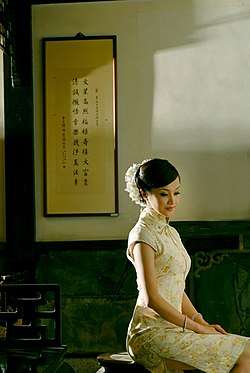 A woman in a cheongsam | |
| Type | Dress |
|---|---|
| Material | Silk, cotton |
| Place of origin | China |
| Cheongsam | |||||||||||||||||||||||||||
|---|---|---|---|---|---|---|---|---|---|---|---|---|---|---|---|---|---|---|---|---|---|---|---|---|---|---|---|
.svg.png) "Cheongsam" in Traditional (top) and Simplified (bottom) Chinese characters | |||||||||||||||||||||||||||
| Traditional Chinese | 長衫 | ||||||||||||||||||||||||||
| Simplified Chinese | 长衫 | ||||||||||||||||||||||||||
| Literal meaning | long garment | ||||||||||||||||||||||||||
| |||||||||||||||||||||||||||
| Qipao | |||||||||||||||||||||||||||
| Chinese | 旗袍 | ||||||||||||||||||||||||||
| Literal meaning | banner [Manchu] gown | ||||||||||||||||||||||||||
| |||||||||||||||||||||||||||
Terminology
As English loanwords, both "cheongsam" and "qipao" describe the same type of tight-fitting Chinese dress worn by women, and the words could be used interchangeably.[2]
The term "cheongsam" is a romanization of Cantonese word chèuhngsāam (長衫; 'long shirt/dress'), which comes from the Shanghainese term zansae. In Cantonese and Shanghainese, the term is used to describe a Chinese dress popularized in Shanghai. However, in Mandarin Chinese and other varieties of Chinese, chángshān (長衫) refers to an exclusively male garment, and the female version is known as the qípáo.
In Hong Kong, where many Shanghai tailors fled after the communist revolution of 1949, the word chèuhngsāam became gender-neutral, referring to both male or female garments. The word "qipao" (keipo) became a more formal term for the female chèuhngsāam. Usage of the term "cheongsam" in Western countries mostly followed the original Cantonese meaning and applies to the dress worn by women only.
History
Background
When the Manchus ruled China during the Qing dynasty, they used an administrative division called the Eight Banner system. Originally only the Manchu households were organised within this system, but over time Mongols and Han Chinese were incorporated. The Manchus, and anyone living under the Eight Banners system, wore different clothing from ordinary civilians. Thus they became known as Banner People (旗人 pinyin: qí rén). The Manchu clothing that they wore consisted of similar long robes for both men and women. These were called changpao (長袍).
For a period of time, under the dynastic laws after 1636, all Han Chinese were forced under penalty of death to adopt the Manchu male hairstyle, the queue, and dress in Manchu changpao instead of traditional Han Chinese clothing (剃发易服). However, the order for ordinary non-Banner Han civilians to wear Manchu clothing was lifted, and only those Han who served as officials or scholars were required to wear them. Over time though, some Han civilian men voluntarily adopted changshans. By the late Qing, not only officials and scholars, but a great many commoner Han men wore Manchu male attire.[3][4] Until 1911, the Manchu changpao was required clothing for Chinese men of a certain class.
For women, Manchu and Han systems of clothing coexisted.[5] Throughout the Qing dynasty, Han civilian women continued to wear traditional Han clothing from the Ming dynasty.[6] As a result, Ming dynasty style clothing was retained in some places in China until the Xinhai Revolution of 1911.[7]
Birth of the cheongsam
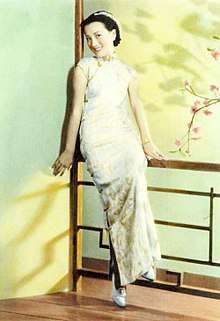
The original qipao fitted loosely and hung in an A-line.[8] It covered most of the wearer's body, revealing only the head, hands, and the tips of the toes. The baggy clothing also served to conceal the figure of the wearer regardless of age.
The version seen as the typical cheongsam in China today was popularized by the celebrities, socialites and politicians of the time in Shanghai from the 1920s to the 1940s. Former First Lady of China Madame Wellington Koo was a prominent figure among them.[9][10] Voted several times by Vogue into its lists of the world's best-dressed women, Madame Wellington Koo was much admired for her adaptations of the traditional Manchu fashion, which she wore with lace trousers and jade necklaces.[9][10] Cheongsam dresses at the time had been decorously slit a few inches up the sides, but Madame Koo slashed hers to the knee, 'with lace pantelettes just visible to the ankle'.[10] Unlike other Asian socialites, Madame Koo also insisted on local Chinese silks, which she thought were of superior quality.[9][10]
Further transformation

People eagerly sought a more modernized style of dress and transformed the old cheongsam to suit new tastes. Slender and tight-fitting with a high cut, it had great differences from the traditional cheongsam. High-class courtesans and celebrities in the city made these redesigned tight fitting cheongsam popular at that time.[11] In Shanghainese, it was first known as zansae for 'long dress', rendered in Mandarin as chángshān and in Cantonese as chèuhngsāam; it is the last of these spoken renditions of 長衫 that was borrowed into English as "cheongsam".
In the beginning, cheongsam were always worn with trousers, as were the male changpao. With the introduction of Western fashion during the Nanjing decade (1927–1937), many people replaced trousers with stockings. The side slits were re-purposed into aesthetic design reaching top of thigh to reflect new fashion trend. By the 1940s, trousers had completely fallen out of use, replaced by different type of hosiery. High-heeled shoes were another fashion trend introduced to Shanghai at the same time, and it became an essential part of cheongsam fashion set, which continued into modern days.[12] As trend of hosiery in turn declined in later decades, women started to wear cheongsam more commonly with bare legs. While this development settled the cheongsam as a one-piece dress, by contrast, the related Vietnamese áo dài retained trousers.
The modernized version of cheongsam is noted for accentuating the figures of women, and as such was popular as a dress for high society. As Western fashions evolved, so does the cheongsam design, with introduction of high-necked sleeveless dresses, bell-like sleeves, and the black lace frothing at the hem of a ball gown. By the 1940s, cheongsam came in a wide variety of fabrics with an equal variety of accessories.
The 1949 Communist Revolution curtailed the popularity of the cheongsam and other fashions in Shanghai, but the Shanghainese emigrants and refugees brought the fashion to Hong Kong and Taiwan where it has remained popular. Recently there has been a revival of the Shanghainese cheongsam in Shanghai and elsewhere in Mainland China; the Shanghainese style functions now mostly as a stylish party dress.
Popularity and women's liberation
The Republican period is the golden age of cheongsam. In exploring reasons behind its prevalence in Republic of China, many scholars relate it to the women's liberation movements. After the feudal Qing dynasty was overturned, Chinese feminists called for women's liberation from traditional roles and they led several movements against the Neo-Confucian gender segregation, including a termination of bound feet for women, cutting off long hair which was conventionally symbolized as women's oriental beauty, and encouraging women to wear men's one-piece clothing, Changshan or "changpao".
"Changpao" was traditionally taken as men's patent throughout the long history since Han Dynasty (202 BC to 220) to Qing Dynasty (1616–1911). During that time, Chinese Han female's clothing gradually developed into two pieces. Women were forbidden to wear robes as men did and instead had to wear tops and bottoms known as "Liang jie yi". After the Xinhai Revolution of 1911 (which overthrew the Qing dynasty), young Chinese people began to learn Western science and cultures in order to seek a way of saving the nation. Also, the opening of several ports and ceding territories of China to Western powers imported Western civilization abundantly to mainland China. Among all these Western thoughts, the idea of gender equality quickly gained its followers, among whom young female students became its prime advocates.[13]
In the early years of Republican period, wearing cheongsam carried the symbol of promoting gender equality and saving the country. The color of cheongsam were usually cold and rigid. It symbolized a silent protest, as part of the May Fourth Movement and the New Cultural Movement.
Since 1930s, cheongsam was popularized from young female students to all women in China regardless of their ages and social status. More and more female workers and celebrities put on cheongsam. The style of cheongsam also varied due to Western influence. It changed from a wide and loose style to a more form fitting and revealing cut, which put more emphasis on women’s body line. The length of cheongsam was also reduced from ankle reaching to above the knee.
The design of cheongsam got various inventions like ruffled collar, bell-like sleeves and black lace frothing. Starting from that, the priority of cheongsam moved from a political expression to aesthetic and ornamental emphasis.
Timeline of Chinese dress
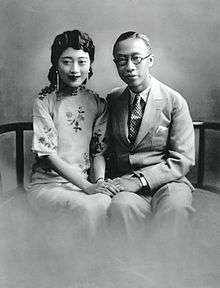
Starting from the Qing Dynasty, changpao, which was the early form of cheongsam, was the daily clothes of Manchus Bannerman. Apart from cheongsam, changpao was a long robe without sleeves and collars.[14]
Until the 1920s, right after the overthrow of the Qing Dynasty and founding of the Republic of China, cheongsam was originated in Shanghai. Cheongsam of the early 1920s had loose cutting, with long, wide sleeves. Affected by Western culture, cheongsam kept on changing, such as becoming more fitted and body-hugging, with side slits that reached up to the thigh.[15] [16]Moreover, numerous distinct designs were unveiled and cheongsam became a fashion trend.[17]
In 1929, cheongsam was chosen by the Republic of China to be one of the national dresses. In the 1930s, the fashion prevailed in Shanghai. At that time, cheongsam was made of silk and embroidered with pearls and other decorations. Also, they were close fitting, and drew the outline of the wearer's body.
In 1940s, cheongsam was worn with stockings, and trousers had completely fallen out of use. High-heeled shoes became an essential part of the cheongsam fashion set.[12]
From the 1950s to the 1970s, due to the anti-tradition movements in China, especially the Chinese Cultural Revolution (1966–1976), the cheongsam was seen as a feudal dress of the ancient times. It was abandoned as daily clothing, and people who wore cheongsams were judged as being bourgeois, which was considered a political misbehavior at that time. For example, in 1963, when President Liu Shaoqi visited four neighboring countries in South Asia, first lady Wang Guangmei wore a cheongsam. She was later declared guilty in the Cultural Revolution for wearing a cheongsam.
Since 1980s, with the trend of reevaluation of Chinese traditional culture, people in mainland China started to pay attention to the cheongsam again. The cheongsam is gaining popularity in films, beauty pageants, and fashion shows in both China and other countries all over the world. In 1984, the cheongsam was specified as the formal attire of female diplomatic agents by the People's Republic of China.

Daoguang Period
(1821–1850)
Empress Xiaoshen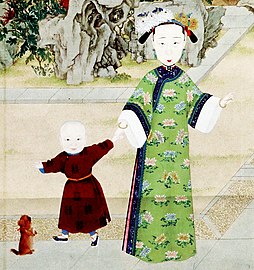
Daoguang Period
(1821–1850)
Empress Xiaojingcheng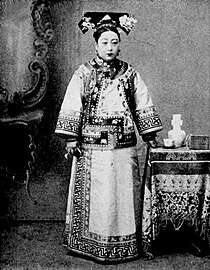
Guangxu Period
(1875–1908)
Lady Heseri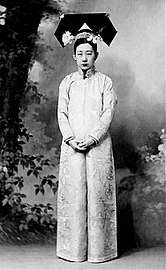
Guangxu Period
(1875–1908)
Lady Aixingioro Hengxiang
Republican Period
(1913–1949)
Noble Consort Mingxian
Modern use
Workplace
.jpg)
Some airlines in Mainland China and Taiwan, such as China Airlines[18] and Hainan Airlines[19], have cheongsam uniforms for their women flight attendants and ground workers. These uniform cheongsams are in a plain color, hemmed just above the knee, with a close-fitting wool suit jacket of the same color as the cheongsam.
In the 1950s, women in the workforce in Hong Kong started to wear more functional cheongsam made of wool, twill, and other materials. Most were tailor fitted and often came with a matching jacket. The dresses were a fusion of Chinese tradition with modern styles. Cheongsam were commonly replaced by more comfortable clothing such as sweaters, jeans, business suits and skirts. Due to its restrictive nature, it is now mainly worn as formal wear for important occasions. They are sometimes worn by politicians and film artists in Taiwan and Hong Kong. They are shown in some Chinese movies such as in the 1960s film The World of Suzie Wong, where actress Nancy Kwan made the cheongsam briefly fashionable in Western culture. They are also commonly seen in beauty contests, along with swim suits. Today, cheongsam are only commonly worn day to day as a uniform by people like restaurant hostesses and serving staff at luxury hotels.
School uniform
A few primary schools and some secondary schools in Hong Kong, especially older schools established by Christian missionaries, use a plain rimmed sky-blue cotton and/or dark blue velvet (for winter) cheongsam with the metal school badge right under the stand-up collar to be closed with a metal hook and eye as the official uniform for their female students. The schools which use this standard include True Light Girls' College, St. Paul's Co-educational College, Heep Yunn School, St. Stephen's Girls' College, Ying Wa Girls' School, etc. These cheongsam are usually straight, with no waist shaping, and the cheongsam hem must reach mid-thigh. The cheongsam fit closely to the neck, and the stiff collar is hooked closed, despite the tropical humid and hot weather. Although the skirts have short slits, they are too narrow to allow students to walk in long strides. The seams above the slits often split when walking and are repeatedly sewn. Many schools also require underskirts to be worn with the cheongsam. The underskirt is a white cotton full slip, hemmed slightly shorter than the cheongsam, and have slits at the sides like the cheongsam, although the slits are deeper. A white cotton undershirt is often worn underneath the cheongsam. The cheongsam's length, styling, color and sleeve length varies between schools. Many students feel it an ordeal, yet it is a visible manifestation of the strict discipline that is the hallmark of prestigious secondary schools in Hong Kong and many students and their parents like that. Some rebellious students express their dissatisfaction with this tradition by wearing their uniform with the stand-up collar intentionally left unhooked or hemmed above their knees. The Ying Wa and True Light Schools have sent questionnaires to their students about uniform reforms but have not altered their policies.[20] However, Madam Lau Kam Lung Secondary School of Miu Fat Buddhist Monastery ended their cheongsam uniform in 1990 after receiving suggestions from its student union.[21]
Festivities
Cheongsams are a popular choice of outfit for festive seasons like Chinese New Year. In countries with significant Chinese populations such as Malaysia, Singapore, Hong Kong and Taiwan, it is common for women to have new cheongsams tailored in preparation for the New Year. Cheongsams are also a popular choice of outfit for older women on formal occasions or family reunions. Upmarket fashion labels such as Shanghai Tang specialize in modern versions of the cheongsam as occasion wear.
Weddings
In Western weddings, Chinese brides or brides marrying into a Chinese family, will often wear cheongsam for a portion of the wedding day. It is common for many brides to have both a traditional white wedding dress and a cheongsam or kwa to be worn during the tea ceremony. Cheongsam styles have also evolved to be more modern from mermaid silhouettes to semi-traditional styles that feature a cheongsam top with softer details like lace and a looser skirt.[22]
Lolita fashion
Some Lolita dresses are styled like a cheongsam. The dresses or jumper skirts are designed after traditional Chinese dresses. This style of Lolita fashion is called Qi Lolita.[23]
.jpg)
Indonesian actress Aminah Cendrakasih in cheongsam 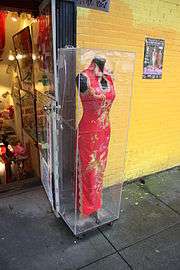
Typical modern cheongsam with high-slit cuts reaching top of the thigh 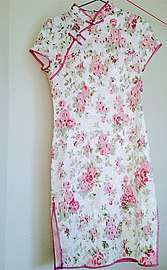
Typical modern cheongsam in short style above the knee .jpg)
Modern cheongsam mini dress
On the international stage
Sport-related
In the 2008 Summer Olympics, the medal bearers wore cheongsam. Similar attire was worn by female members of the Swedish team and of the Spanish team in the opening ceremony, with the national colors.
For the 2012 Hong Kong Sevens tournament, sportswear brand Kukri Sports teamed up with Hong Kong lifestyle retail store G.O.D. to produce merchandising, which included traditional Chinese jackets and cheongsam-inspired ladies' polo shirts.[24][25][26]
Political stage
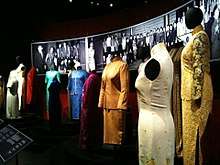
In contemporary China, the meaning of cheongsam has been revisited again. It now embodies an identity of being ethnic Chinese, and thus is used for important diplomatic occasions.
Since 2013, Peng Liyuan, the first lady of China, has worn cheongsam several times while on foreign visits with Chinese president Xi Jinping.
In November 2014, cheongsam was the official attire for the political leaders' wives in the 22nd APEC meeting in Beijing.
International fashion
With the growth of the Chinese economy, cheongsam has experienced a renewed popularity. Many Western designers have integrated elements of cheongsam in their fashion collections. French designer Pierre Cardin once said that cheongsam was his inspiration for many of his evening dress designs.[27] In many films and movies, cheongsam is used to make a fashion statement and an exotic impression. In the 2011 movie One Day, Anne Hathaway wore a set of dark blue cheongsam as evening dress. Many western stars such as Elizabeth Taylor, Nicole Kidman, Paris Hilton, Emma Watson, Deepika Padukone, and Celine Dion have also made public appearances wearing cheongsam.
Controversies on origin
The cheongsam is generally considered to be adapted from the one-piece dress of Manchu women during the Qing dynasty. However, there has been considerable debate on the origin of the cheongsam in academic circles. The following are three common arguments on the origin of the cheongsam:
The first argument says that the cheongsam came directly from the clothing of the banner people when the Manchu ruled China during the Qing dynasty. This argument was prominently represented by Zhou Xibao (周锡保) in his work The History of Ancient Chinese Clothing and Ornaments.[28]
The second opinion holds that the cheongsam inherited some features of the chángpáo of Banner People in the Qing dynasty, but the true origin of the cheongsam dates back to a period between the Western Zhou dynasty (1046 BC – 771 BC) and the pre-Qin era, approximately two millennia before the Qing dynasty. According to Yuan Jieying's (袁杰英) book Chinese Cheongsam, the modern cheongsam[29] shares many similarities with the narrow-cut straight skirt that women wore in the Western Zhou dynasty.[30] And Chinese Professor Bao Minxin (包铭新) also pointed out in his book A Real Record of Modern Chinese Costume that the cheongsam originated from the ancient robe in the Han dynasty (206 BC-220 AD). The robe is a one-piece upper and lower connected long dress which was quite popular among ladies in Han.[31]
The third argument was raised by Bian Xiangyang (卞向阳) in his book An Analysis on the Origin of Qipao. Bian thinks that the cheongsam originates from neither the robe nor the chángpáo. It is an adaption of western-style dress during the Republic of China era when people were open to the western cultures. In his opinion, the cheongsam was a hybrid of traditional Chinese costumes and western costumes such as the waistcoat and one-piece dress.[32]
Similar garments
The Vietnamese áo dài, which originated from the áo ngũ thân is thought to bear some resemblances to the cheongsam. In the 18th century, in an attempt to separate his domain from Tonkin ruled by his rival Trịnh clan and build an independent state, lord Nguyễn Phúc Khoát forced his subjects to relinquish the traditional áo giao lĩnh, a type of crossed-collar robe, found across Sino culture countries, in favor of a type of robe that has upright collar.
See also
Notes and references
- "Qipao (Ch'i-p'ao)". Encyclopædia Britannica. Retrieved 18 November 2008.
- Natalie Proulx (8 May 2018). "Is a Chinese-Style Prom Dress Cultural Appropriation?". New York Times. New York Times.
- Edward J. M. Rhoads (2000). Manchus and Han: Ethnic Relations and Political Power in Late Qing and Early Republican China, 1861–1928. University of Washington Press. pp. 61–. ISBN 978-0-295-98040-9.
- Twitchett, Denis; Fairbank, John K. (2008) Cambridge History of China Volume 9 Part 1 The Ch'ing Empire to 1800, p87-88
- Shaorong Yang (2004). Traditional Chinese Clothing Costumes, Adornments & Culture. Long River Press. p. 7. ISBN 978-1-59265-019-4.
Men's clothing in the Qing Dyansty consisted for the most part of long silk growns and the so-called "Mandarin" jacket, which perhaps achieved their greatest popularity during the latter Kangxi Period to the Yongzheng Period. For women's clothing, Manchu and Han systems of clothing coexisted.
- 周, 锡保 (1 January 2002). 《中国古代服饰史》. 中国戏剧出版社. p. 449. ISBN 9787104003595..
- 千志, 魏 (1998). 《明清史概論》. 中國社會科學出版社. pp. 358–360.
- Zhou, Xibao (January 2011). A history of Ancient Chinese Apparel and Accessories. Beijing: Central Compilation and Translation Press. ISBN 9787511705037.
- Koo, Hui-lan Oei; Van Rensselaer Thayer, Mary (1943). Hui-lan Koo (Madame Wellington Koo): An Autobiography as Told to Mary Van Rensselaer Thayer. New York: Dial Press. Retrieved 24 February 2018.
- "Madame Wellington-Koo – Voted best dressed Chinese Woman of 1920s by Vogue". Nee Hao Magazine. Retrieved 24 February 2018.
- 旗袍起源与哪个民族?
- Dongfang Daily (2 July 2012). "海上名媛与海上旗袍的华丽转身". iFeng (in Chinese). Phoenix Media Group.
- 吴, 昊 (January 2008). 中国妇女服饰与身体革命. 上海: 上海东方出版中心. ISBN 9787801867735.
- "旗袍特展展現女性特質 專訪台灣師傅許榮一 - 大紀元". 大紀元 www.epochtimes.com (in Chinese). 16 May 2013. Retrieved 5 March 2019.
- Gao, Sally. "A Brief History Of The Cheongsam". Culture Trip. Retrieved 5 March 2019.
- "Qipao, a timeless fashion icon". www.news.gov.hk. Retrieved 6 March 2019.
- Chew, Matthew (March 2007). "Contemporary Re-emergence of the Qipao: Political Nationalism, Cultural Production and Popular Consumption of a Traditional Chinese Dress". The China Quarterly. 189: 144–161. doi:10.1017/s0305741006000841. ISSN 0305-7410.
- Clement Huang (25 June 2015). "China Airlines introduces new uniform designs". Business Traveller.
- "Airline Debuts New Haute Couture Uniforms for Flight Attendants at Paris Fashion Week". Cosmopolitan. 10 July 2017.
- 旗袍维系香港女校百年情. 李气虹 (The qipao keep the affections of Hong Kong girls schools of 100 years by Li Qihong) (16 May 2003). "Archived copy". Archived from the original on 19 August 2007. Retrieved 1 October 2007.CS1 maint: archived copy as title (link)
- Madam Lau Kam Lung Secondary School of Miu Fat Buddhist Monastery Archived 14 October 2007 at the Wayback Machine
- "Cheongsam Wedding Dress: A Style Guide for the Modern Bride". East Meets Dress. Retrieved 13 March 2019.
- "East Meets East?? Japanese Lolita Fashion with a Chinese Twist! | KawaCura". KawaCura. 5 March 2015. Retrieved 1 August 2017.
- "G.O.D. and Kukri Design Collaborate for the Rugby Sevens". Hong Kong Tatler. 16 March 2012. Archived from the original on 15 August 2012. Retrieved 19 November 2012.
- "G.O.D. x Kukri". G.O.D. official website. Archived from the original on 15 May 2012. Retrieved 19 November 2012.
- "Kukri and G.O.D. collaborate on HK7s Range!". Kukri Sports. Archived from the original on 2 February 2014. Retrieved 19 November 2012.
- "Chinese Symbolic Qipao Dress History And Meaning?".
- 周, 锡保 (September 1984). 中国古代服饰史. 北京: 中国戏剧出版社. ISBN 9787104003595.
- "What is modern cheongsam ". Newhanfu.
- 袁, 杰英 (January 2002). 中国旗袍. 北京: 中国纺织出版社. ISBN 9787506417075.
- 包, 铭新 (December 2004). 近代中国女装实录. 上海: 东华大学出版社. ISBN 9787810388870.
- 卞, 向阳 (November 2003). "论旗袍的流行起源". 装饰 (11). J523.
Bibliography
- Bai Yun (2006). Zhongguo lao qipao: lao zhaopian lao guanggo jianzheng qipao de yanbian [The traditional qiapo of China: evidence of its [stylistic] changes in old photographs and old advertisements]. Beijing: Guangming ribao chubanshe. ISBN 9787802061866. OCLC 123015683.
- Bao Mingxin; Ma Li, eds. (1998). Zhongguo Qipao [China's Qipao]. Shanghai: Shanghai wenhua chubanshe. ISBN 9787805119960. OCLC 51630832.
- Chang, Eileen (Zhang Ailing) (Fall 2003). Andrew F. Jones, trans. "A Chronicle of Changing Clothes". Positions: East Asia Culture Critique. 11 (2): 427–441. doi:10.1215/10679847-11-2-427. Archived from the original on 15 November 2013. Retrieved 6 July 2012.
- Clark, Hazel (2000). The Cheongsam. Images of Asia. Hong Kong: Oxford University Press (China). ISBN 9780195909395. OCLC 44876865.
- Finnane, Antonia (2007). "Chapter 6: Qipao China". Changing Clothes in China: Fashion, History, Nation. New York: Columbia University Press. pp. 139–176. ISBN 9780231143509. OCLC 84903948.
- Roberts, Claire (ed.) (1997). Evolution and Revolution: Chinese Dress 1700s–1900s. Sydney: Powerhouse Pub., Museum of Applied Arts and Sciences. ISBN 9781863170673. OCLC 37745658.CS1 maint: extra text: authors list (link)
- Lee, Chor Lin; Chung May Khuen (2012). In the Mood for Cheongsam: A Social History, 1920s–Present. Singapore: Editions Didier Millet and National Museum of Singapore. ISBN 9789814260923. OCLC 767566394.
- Schmitz, Rob (2 June 2012). "The Street of Eternal Happiness: The Tailor". Marketplace. Retrieved 22 June 2012. About a tailor of cheongsam who has been in the business for nearly 80 years.
- Van Roojen, Pepin (2009). Cheongsam 旗袍 (Book + CD-ROM). Pepin Fashion, Textiles & Patterns, no. 1. Amsterdam: Pepin Press. ISBN 9789460090011. OCLC 632704710.
External links
| Wikimedia Commons has media related to Qipao. |
- About.com entry on the qipao
- Documentary on the qipao on CCTV website